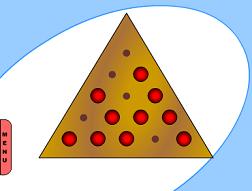

On an English board, the hole can be anywhere and the final peg can only end up where multiples of three permit. Also starting with one hole here and ending with one peg there. Other alternate games include starting with two empty holes and finishing with two pegs in those holes. This technique can be used with a line of 3, a block of 2♳ and a 6-peg L shape with a base of length 3 and upright of length 4. In the example below, the * is the catalyst.: There are, however, several other configurations where a single initial hole can be reduced to a single peg.Ī tactic that can be used is to divide the board into packages of three and to purge (remove) them entirely using one extra peg, the catalyst, that jumps out and then jumps back again.

Hence a final position with only one peg cannot be reached, since that would require that one of these numbers is one (the position of the peg, one is odd), while the other two numbers are zero, hence even. Hence after an even number of moves all these three numbers are even, and after an odd number of moves all these three numbers are odd.

After every move the number of covered A positions increases or decreases by one, and the same for the number of covered B positions and the number of covered C positions. Initially with only the central position free, the number of covered A positions is 12, the number of covered B positions is 12, and also the number of covered C positions is 12. Divide the positions of the board into A, B and C positions as follows: This is easily seen as follows, by an argument from Hans Zantema. There is no solution to the European board with the initial hole centrally located, if only orthogonal moves are permitted. On the English board the equivalent alternative games are to start with a hole and end with a peg at the same position. This mirror image notation is used, amongst other reasons, since on the European board, one set of alternative games is to start with a hole at some position and to end with a single peg in its mirrored position. There are many different solutions to the standard problem, and one notation used to describe them assigns letters to the holes: On an English board, the first three moves might be: Thus valid moves in each of the four orthogonal directions are: A blue ¤ is the hole the current peg moved from a red * is the final position of that peg, a red o is the hole of the peg that was jumped and removed.

Peg solitaire, Solo Noble or simply Solitaire is a board game for one player involving movement of pegs on a board with holes. The Princess of Soubise playing solitaire, 1697


 0 kommentar(er)
0 kommentar(er)
